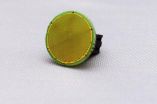(Press-News.org) COLUMBUS, Ohio – New research suggests that zinc helps control infections by gently tapping the brakes on the immune response in a way that prevents out-of-control inflammation that can be damaging and even deadly.
Scientists determined in human cell culture and animal studies that a protein lures zinc into key cells that are first-responders against infection. The zinc then interacts with a process that is vital to the fight against infection and by doing so helps balance the immune response.
This study revealed for the first time that zinc homes in on this pathway and helps shut it down, effectively ensuring that the immune response does not spiral out of control. The team led by Ohio State University researchers also found that if there is not enough zinc available at the time of infection, the consequences include excessive inflammation.
In this research, zinc's activity was studied in the context of sepsis, a devastating systemic response to infection that is a common cause of death in intensive-care unit patients. But scientists say these findings might also help explain why taking zinc tablets at the start of a common cold appears to help stem the effects of the illness.
"We do believe that to some extent, these findings are going to be applicable to other important areas of disease beyond sepsis," said Daren Knoell, senior author of the study and a professor of pharmacy and internal medicine at Ohio State. "Without zinc on board to begin with, it could increase vulnerability to infection. But our work is focused on what happens once you get an infection – if you are deficient in zinc you are at a disadvantage because your defense system is amplified, and inappropriately so.
"The benefit to health is explicit: Zinc is beneficial because it stops the action of a protein, ultimately preventing excess inflammation."
While this study and previous work linking zinc deficiency to inflammation might suggest that supplementation could help very sick ICU patients, it's still too early to make that leap.
"I think the question is whom to give zinc to, if anybody at all. We predict that not everybody in the ICU with sepsis needs zinc, but I anticipate that a proportion of them would," Knoell said. "Zinc is a critical element that we get from our diet, but we do not think we can give zinc and fix everything. Usually, if there is zinc deficiency, we would expect to see other nutrient deficiencies, too."
Zinc deficiency affects about 2 billion people worldwide, including an estimated 40 percent of the elderly in the United States – who are also among the most likely Americans to end up in an ICU.
The research is published in the journal Cell Reports.
Knoell's lab previously showed that zinc-deficient mice developed overwhelming inflammation in response to sepsis compared to mice on a normal diet. Zinc supplementation improved outcomes in the zinc-deficient mice.
Until now, the beneficial effects of zinc in combating infection have not been fully understood at the molecular level. This is because zinc has numerous complex jobs in the body and interacts with thousands of proteins to sustain human life. Of all the zinc contained in our bodies, only about 10 percent of it is readily accessible to help fight off an infection, said Knoell, also an investigator in Ohio State's Davis Heart and Lung Research Institute.
"We believe that our findings help to narrow an important gap that has existed in our understanding of how this relatively simple metal helps us defend ourselves from infection," he said.
In this work, Knoell and colleagues sought to zero in on zinc's role in preventing the inflammation that had led to such poor outcomes in the zinc-deficient mice.
In experiments using human monocytes – cells involved in the first line of defense against an invading pathogen – the researchers examined what happens when the immune response is launched.
When a pathogen is recognized, a series of molecules wake up from dormancy to create a process that activates the innate immune response. A major part of this process involves the NF-κB pathway, named for a highly active protein that is known to play an important role in the immune response to infection. Once NF-κB is activated and enters the nucleus, a gene is expressed that produces a zinc transporter called ZIP8. The transporter then rapidly mobilizes to the cell's wall, where it can then shuttle zinc from the bloodstream into the cell.
After cell entry, zinc is then directed to and binds to a different protein in the NF-kB pathway. When this happens, it halts any further activity in that process. The cumulative impact of this feedback loop is that it prevents excessive inflammation, which can be damaging to cells and the body.
"The immune system has to work under very strict balance, and this is a classic example of where more is not always better," Knoell said. "We want a robust inflammatory response, which is part of our natural programming to defend us against a bug. But if that is unchecked, and there is too much inflammation, then it not only attacks the pathogen but can also cause much more collateral damage."
The researchers knew from previously published experiments that if ZIP8 activation was prevented, zinc couldn't come into the cell and the cells died. In the current study, collaborators who specialize in computational modeling of protein interactions helped identify the likely target of zinc once it enters the cell: specific binding sites on a protein called IKKB. When researchers allowed this protein to function unchecked in mice with zinc deficiency, the animals developed excessive inflammation in response to sepsis – confirmation that IKKB was zinc's target to turn off the inflammatory pathway.
"There are certainly other zinc targets in the cell, but we found evidence that zinc is brought in by ZIP8 to turn the pathway off by interacting with this protein at a specific region," Knoell said.
The recommended daily allowance for zinc ranges from 8 to 11 milligrams for most adults. Red meat and poultry provide the majority of zinc in the American diet, according to the National Institutes of Health. Other food sources include beans, nuts, some shellfish, whole grains, fortified cereals and dairy products. The nutrient is also available in supplement form. Knoell said it is possible but relatively uncommon to take in too much zinc to reach toxic levels.
His lab is continuing to study the NF-κB pathway, inflammation and zinc deficiency in other disease processes. And though zinc would be inexpensive and easy to take as a supplement, Knoell said many questions remain about whether zinc should be considered as an intervention for specific disorders.
"There might be therapeutic implications about giving supplemental zinc in a strategic manner to help improve some people with certain conditions. But also, could we learn from this so someday we can be more diagnostic about who it is that needs zinc? And if so, what dose and for how long?" he said.
###
This work was supported by the National Institutes of Health and the Lifeline of Ohio Tissue Procurement Agency.
Co-authors include Ming-Jie Liu, Shengying Bao, Charlie Pyle, Andrew Rudawsky and Mark Wewers of the Davis Heart and Lung Research Institute; Marina Gálvez-Peralta and Daniel Nebert of the University of Cincinnati Medical Center; Ryan Pavlovicz and Chenglong Li of Ohio State's Biophysics Program (Li is also in the College of Pharmacy); and David Killilea of Children's Hospital Oakland Research Institute.
Contact: Daren Knoell, (614) 292-0075; Daren.Knoell@osumc.edu
Written by Emily Caldwell, (614) 292-8310; Caldwell.151@osu.edu
Zinc helps against infection by tapping brakes in immune response
2013-02-07
ELSE PRESS RELEASES FROM THIS DATE:
Study shows disease spread in ladybirds with sexually transmitted disease
2013-02-07
A study at the University of Liverpool into the spread of sexually transmitted infection in ladybirds has shown that disease risk to large populations cannot be predicted without a full understanding of the disease dynamics at small geographical scale.
Scientists investigated a virulent form of infection in the central and northern European populations of the two-spot ladybird to understand the conditions that favoured disease spread. Researchers found that disease burden in two locations of the same habitat – the lime tree - were very different, despite being within ...
New technology may help doctors monitor concussions, aging, and neurological function
2013-02-07
Boston, MA, Feb. 7, 2013 – Doctors routinely track their patients' hand-eye coordination to monitor any neuromuscular deficits, particularly as patients age or when they are injured -- but the tests they have been using to track this kind of information may be subjective and qualitative.
Researchers at the Wyss Institute for Biologically Inspired Engineering at Harvard University, the Beth Israel Deaconess Medical Center, and Hebrew SeniorLife, Boston (BIDMC), recently completed the first clinical study of a new rapid neuroassessment device they developed to quantitatively ...
Unique peptide could treat cancers, neurological disorders, and infectious diseases
2013-02-07
DALLAS – Feb. 7, 2013 – UT Southwestern Medical Center scientists have synthesized a peptide that shows potential for pharmaceutical development into agents for treating infections, neurodegenerative disorders, and cancer through an ability to induce a cell-recycling process called autophagy.
Autophagy is a fundamental recycling process in which intracellular enzymes digest unneeded and broken parts of the cell into their individual building blocks, which are then reassembled into new parts. The role of autophagy is crucial both in keeping cells healthy and in enabling ...
Compound developed by scientists protects heart cells during and after attack
2013-02-07
JUPITER, FL, February 7, 2013 – Using two different compounds they developed, scientists from the Florida campus of The Scripps Research Institute (TSRI) have been able to show in animal models that inhibiting a specific enzyme protects heart cells and surrounding tissue against serious damage from heart attacks. The compounds also protect against additional injury from restored blood flow after an attack, a process known as reperfusion.
The study, which was led by Philip LoGrasso, a professor and senior scientific director of discovery biology at Scripps Florida, appears ...
Social network use reflects East-West disparity
2013-02-07
EAST LANSING, Mich. — The stark contrast between America's "me-first" culture and the "collective-good" mentality in China is reflected in the two countries' use of social networking sites, according to a new study led by a Michigan State University scholar.
U.S. citizens spend more time on the networking sites, consider them to be more important and have more "friends" on the sites, the research found. The most popular social networking site in the United States is Facebook; in China it's Ozone.
Linda Jackson, MSU professor of psychology, said Chinese citizens tend ...
Health costs of income inequality in marriage, jealousy and parenting, humor and conflict
2013-02-07
In time for Valentine's Day, Personality and Social Psychology Bulletin is featuring several new studies all about relationships – including the link between income in marriage and health, the role of jealousy in becoming a parent, and how humor affects romantic couples in conflict.
Being the breadwinner has health costs
Men whose wives earn more income are more likely to use erectile dysfunction medication than those who outearn their wives, even when the inequality is small, according to a new study. Researchers looking at more than 200,000 married couples in Denmark ...
Smart satnav drives around the blue highway blues
2013-02-07
Endlessly frustrated by congested roads, computer scientists at California State University, in Fullerton have developed a satellite navigation system, GeoTNavi, which hooks into historical traffic data and current vehicle movements to find the shortest commute and avoid the traffic jams.
Writing in the latest issue of the International Journal of Data Mining, Modelling and Management, Shawn Wang and colleagues explain how the California highway system is one of the most complicated and busiest highway systems in the USA with well over 83% of urban interstate congestion. ...
Permanent stress can cause type 2 diabetes in men
2013-02-07
Men who reported permanent stress have a significantly higher risk of developing type 2 diabetes than men who reported no stress. This is the finding of a 35-year prospective follow-up study of 7,500 men in Gothenburg, by the University of Gothenburg, Sweden.
Since the 1970s, a large population based cohort study has been undertaken at the Sahlgrenska Academy, University of Gothenburg to monitor the health of men born in Gothenburg between 1915 and 1925.
Using this unique material, researchers are now able to show that permanent stress significantly increases the risk ...
A Spanish breakthrough allows the electroporation of cell cultures for less than 1 Euro
2013-02-07
Researchers from the Polytechnic University of Catalonia have developed a technique that improves and cuts the cost of a technique called electroporation, which involves opening pores in cell membranes using an electric field to introduce substances like drugs and DNA. Current methods are aggressive and expensive whereas the new system manages to apply low voltage electroporation with a small printed circuit board, which costs less than a Euro per unit and does not damage cells.
Two US firms in Boston and San Francisco operating in the biotechnology equipment sector have ...
Asians are far more likely than Anglos to be college-educated
2013-02-07
Asians (about 60 percent) are much more likely to be college-educated than Anglos (under 40 percent), according to Rice University's Kinder Institute Houston Area Asian Survey, the first systematic look at the local Asian population based on three surveys conducted over a 16-year period. The findings were released today by Stephen Klineberg, Kinder Institute co-director and Rice sociologist, at an event hosted by the institute at the Asia Society Texas Center.
The surveys, conducted in 1995, 2002 and 2011 in conjunction with the annual Kinder Institute Houston Area Survey, ...



